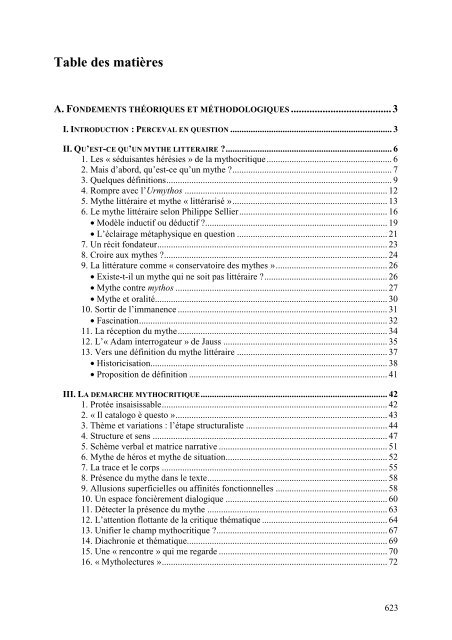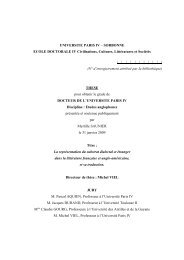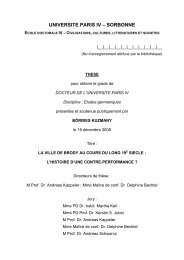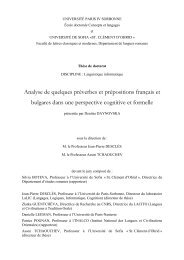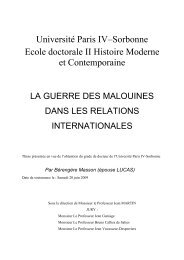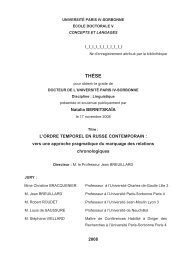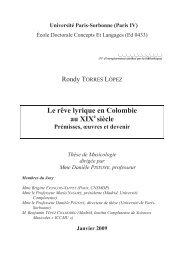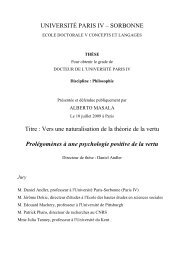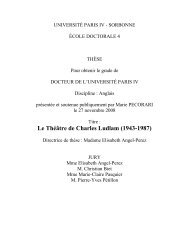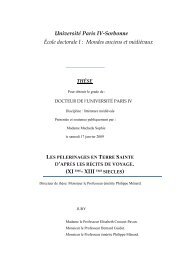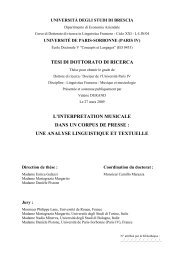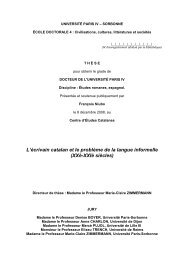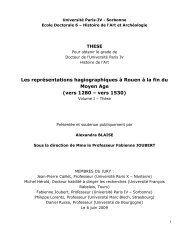- Page 1 and 2:
En quête de Perceval Étude sur un
- Page 3 and 4:
A. FONDEMENTS THÉORIQUES ET MÉTHO
- Page 5 and 6:
que cet objet me dictera, de maniè
- Page 7 and 8:
Le « dictionnaire » de mythocriti
- Page 9 and 10:
anglais que vers 1830 ; l’Académ
- Page 11 and 12:
tracé narratif combinant ces deux
- Page 13 and 14:
« production et réception sont é
- Page 15 and 16:
même un soubassement oral ou soit
- Page 17 and 18:
Pour approfondir la question, Selli
- Page 19 and 20:
Nous tenons donc là trois critère
- Page 21 and 22:
le premier à cause de la « séria
- Page 23 and 24:
7. Un récit fondateur Pourtant, ma
- Page 25 and 26:
Mais quelques problèmes subsistent
- Page 27 and 28:
mythe nous parvient tout enrobé de
- Page 29 and 30:
épiphanie que Marcel Detienne a d
- Page 31 and 32:
mythe ne s’offre pas à notre sai
- Page 33 and 34:
ici réinjectée, en aval du récit
- Page 35 and 36:
Après Eco et Iser, il faut encore
- Page 37 and 38:
Le passage d’une fonction théolo
- Page 39 and 40:
littéraire, qui couche les textes
- Page 41 and 42:
mythe « résum[e] un nombre infini
- Page 43 and 44:
2. « Il catalogo è questo » Le p
- Page 45 and 46:
C’est, du moins, ce que suggère
- Page 47 and 48:
des explications évhéméristes, a
- Page 49 and 50:
implication de son intériorité co
- Page 51 and 52:
du phénomène qu’elle représent
- Page 53 and 54:
surtout sur le nom propre) que déf
- Page 55 and 56:
Les réflexions qui précèdent ind
- Page 57 and 58:
(identification de la citation comm
- Page 59 and 60:
Je prends un exemple : dans « El D
- Page 61 and 62:
se révèle même pernicieuse dans
- Page 63 and 64:
celui que le lexicologue opère pou
- Page 65 and 66:
thématiciens) n’est-elle pas la
- Page 67 and 68:
offrent la psychanalyse freudienne
- Page 69 and 70:
egard. C’est dans ce sens que l
- Page 71 and 72:
auteur et d’un mythe. Certaines r
- Page 73 and 74:
en lumière la bilatéralité de l
- Page 75 and 76:
IV. A propos du « mythe de Perceva
- Page 77 and 78:
Or, s’il est un mythe qui corresp
- Page 79 and 80:
qu’elles délimitaient des traces
- Page 81 and 82:
chasse, le jeune homme rencontre ci
- Page 83 and 84:
8. Les gouttes de sang sur la neige
- Page 85 and 86:
aux manuscrits édités par William
- Page 87 and 88:
manuscrits, Ambroise Firmin-Didot),
- Page 89 and 90:
Signalons que toute la partie qui p
- Page 91 and 92:
été écrit en prose. Certains cri
- Page 93 and 94:
conjugue - de façon déroutante ma
- Page 95 and 96:
un manuscrit en écriture arabe, au
- Page 97 and 98:
chez Chrétien, aux aventures de Ga
- Page 99 and 100:
appelé le Bliocadran 160 , du nom
- Page 101 and 102:
Cette combinaison d’éléments a
- Page 103 and 104:
numérotant 168 . Comme les deux cy
- Page 105 and 106:
preuve de courtoisie et de ramener
- Page 107 and 108:
oi demande à Perceval quel est son
- Page 109 and 110:
Du même coup, la boucle de la Quat
- Page 111 and 112:
cortège du graal comprend une ép
- Page 113 and 114:
En adoptant un point de vue plus re
- Page 115 and 116:
après telle autre variante) est au
- Page 117 and 118:
Bretagne en assez haute estime pour
- Page 119 and 120:
Au moins connaissait-on, de cette l
- Page 121 and 122:
choses subsistent de tout le surcod
- Page 123 and 124:
Perceval, le translateur évoque au
- Page 125 and 126:
Croisant les feux de l’anthropolo
- Page 127 and 128:
eût saisi que la neige recouvrait
- Page 129 and 130:
vue qui seront utiles pour rendre c
- Page 131 and 132:
temps que de lire des chevaleries
- Page 133 and 134:
grossièreté des honnêtes barbare
- Page 135 and 136:
échanges entre les deux sphères a
- Page 137 and 138:
Depuis que le goût d’imprimer su
- Page 139 and 140:
• Les deux Perceval de la BUR Or,
- Page 141 and 142:
Tressan serait-il allé rechercher
- Page 143 and 144:
figurent dans l’extrait de son pr
- Page 145 and 146:
espectives. Mais la coloration gén
- Page 147 and 148:
Sans doute, « ces travaux sont for
- Page 149 and 150:
• Comprendre le chevalier amoureu
- Page 151 and 152:
miniatures ne se profile le moindre
- Page 153 and 154:
présent » ; ce sont, au contraire
- Page 155 and 156:
certains, apparemment, estiment qu
- Page 157 and 158:
C’est que, très manifestement, i
- Page 159 and 160:
Ce que l’Antiquité nous propose,
- Page 161 and 162:
peindre une période où les hommes
- Page 163 and 164:
Une telle vision apparaît en quelq
- Page 165 and 166:
Cette légèreté de ton se retrouv
- Page 167 and 168:
La seconde digression est un bon ex
- Page 169 and 170:
La matière est bien, globalement,
- Page 171 and 172:
Un peu plus loin, Perceval apparaî
- Page 173 and 174:
Trop fatigué par ses autres exploi
- Page 175 and 176:
dépérissement de l’arbre » 281
- Page 177 and 178:
des manuscrits, et nous nous ferons
- Page 179 and 180:
comme le grand pionnier d’une nou
- Page 181 and 182:
kyrielle de poètes et d’érudits
- Page 183 and 184:
• Des Lumières au romantisme : u
- Page 185 and 186:
emarquablement large, comme en tém
- Page 187 and 188:
non, Monsieur, je n’ai point parl
- Page 189 and 190:
Il n’en reste pas moins que le su
- Page 191 and 192:
Table-Ronde infiniment plus de char
- Page 193 and 194:
que les partisans d’une origine c
- Page 195 and 196:
• Peredur, Peronik, Lez-Breiz : l
- Page 197 and 198:
traditionnelles, attribuant à un d
- Page 199 and 200:
au monde intellectuel français à
- Page 201 and 202:
émanations de la culture populaire
- Page 203 and 204:
structures symétriques, d’incarn
- Page 205 and 206:
ii. Wagner et les wagnériens 1. Ri
- Page 207 and 208:
Indépendamment même des intérêt
- Page 209 and 210:
Tannhäuser et Lohengrin, l’histo
- Page 211 and 212:
Si l’on suit cette conception, on
- Page 213 and 214:
attisé par le souffle du Zeitgeist
- Page 215 and 216:
(« durch Mitleid wissend, der rein
- Page 217 and 218:
La découverte de ce noyau coïncid
- Page 219 and 220:
où le passé est marqué de maniè
- Page 221 and 222:
parvenant pas à ses fins, il lance
- Page 223 and 224:
Or, dans Opéra et drame déjà, Wa
- Page 225 and 226:
de la fin du XIXème siècle étant
- Page 227 and 228:
On pourra se rappeler ici que Lévi
- Page 229 and 230:
Et il précise : Achèvement désig
- Page 231 and 232:
Comment la figure de Parsifal s’e
- Page 233 and 234:
Gloire des cheveux blonds frissonna
- Page 235 and 236:
d’autres drames de Wagner : en 18
- Page 237 and 238:
Avec un lourd trophée à son bras
- Page 239 and 240:
Partant donc du principe que des mo
- Page 241 and 242:
assisté, en silence, le Perceval d
- Page 243 and 244:
5. Comment peut-on être wagnérien
- Page 245 and 246:
sur scène, de façon fort inattend
- Page 247 and 248:
passion charnelle, tandis que celui
- Page 249 and 250:
s’écrie-t-il tandis qu’il « r
- Page 251 and 252:
Il n’en reste pas moins que Ferva
- Page 253 and 254:
décrite, en revenant de Bayreuth.
- Page 255 and 256:
Dans cette prairie nous ne voyons n
- Page 257 and 258:
compris » (p. 270). Comprendre Par
- Page 259 and 260:
« Vous autres, les purs, vous ête
- Page 261 and 262:
Kundry tient son rang parmi les fem
- Page 263 and 264:
iii. Après Wagner 1. La déwagnér
- Page 265 and 266:
contre-nature. Je méprise quiconqu
- Page 267 and 268:
C’est donc sur une vision assez c
- Page 269 and 270:
manqueraient pas d’en tirer quelq
- Page 271 and 272:
de Louise Clermont et Le Triomphe d
- Page 273 and 274:
• Pénitent ou surhomme ? Un autr
- Page 275 and 276:
• Triomphes du christianisme Cett
- Page 277 and 278:
graal resplendir sur scène tandis
- Page 279 and 280:
latins, les bâtards de France » q
- Page 281 and 282:
C’est d’ailleurs aussi en terme
- Page 283 and 284:
servir plus d’une fois de grille
- Page 285 and 286:
fagot. Je n’invente pas d’unive
- Page 287 and 288:
plus explicite), la dissipation des
- Page 289 and 290:
Perceval, il faut pourtant remarque
- Page 291 and 292:
De l’avoir pris, tu m’as rendu
- Page 293 and 294:
promis qu’« en d’autres temps
- Page 295 and 296:
Vénus en évoquant successivement
- Page 297 and 298:
à travers le temps et les grandes
- Page 299 and 300:
Religion révélée, une organisati
- Page 301 and 302:
à Dieu et à la nature resplendiss
- Page 303 and 304:
son nom et à la connaissance de so
- Page 305 and 306:
Du moment que Parsifal est tendu à
- Page 307 and 308:
errante, […] elle est l’une des
- Page 309 and 310:
Et puis, après une longue interrup
- Page 311 and 312:
Galaad est ici décrit comme une so
- Page 313 and 314:
manière : dans la Fin des Temps av
- Page 315 and 316:
La fin de tous enchantements : C’
- Page 317 and 318:
Si Perceval n’est pas son objet s
- Page 319 and 320:
C. APPROCHES THÉMATIQUES Après av
- Page 321 and 322:
C’est-à-dire, selon ses termes 5
- Page 323 and 324:
Il y aurait, enfin, des « foyers d
- Page 325 and 326:
est placé en face de Gauvain : ce
- Page 327 and 328:
ces termes : « Le Prédestiné est
- Page 329 and 330:
Pour ce qui est de la variante « l
- Page 331 and 332:
4. Le silence de la terre gaste Pou
- Page 333 and 334:
majeure qu’a eue sur lui le livre
- Page 335 and 336:
se présente devant lui ; c’est a
- Page 337 and 338:
le contenu initial : une tête tran
- Page 339 and 340:
descovert »), si ce n’est que la
- Page 341 and 342:
dans lequel « il y avait autant de
- Page 343 and 344:
correspond à la lecture que Percev
- Page 345 and 346:
la neige » 584 . L’image fixée
- Page 347 and 348:
ce motif tantôt se reproduire dans
- Page 349 and 350:
II. Structures relationnelles Aprè
- Page 351 and 352:
Il paraît bien naturel qu’un cer
- Page 353 and 354:
lui être livrée est celle d’un
- Page 355 and 356:
le mettre au centre de son texte, d
- Page 357 and 358:
le faire chevalier 607 . Cet épiso
- Page 359 and 360:
l’hypothèse qu’il était situ
- Page 361 and 362:
Comment ne pas rapprocher la config
- Page 363 and 364:
ce n’est pas un « initié » (Ro
- Page 365 and 366:
nature de ce lien. Dans l’ordre d
- Page 367 and 368:
Roubaud porte ensuite plus précis
- Page 369 and 370:
parole : comment ne pas songer au R
- Page 371 and 372:
quant à Gauvain, il le connaît bi
- Page 373 and 374:
Ainsi, Perceval se dinsinguerait de
- Page 375 and 376:
édition du Lancelot, 27 versions d
- Page 377 and 378:
le frere au roi Pellinor & le frere
- Page 379 and 380:
Quant aux deux autres frères de la
- Page 381 and 382:
„Siehe, auch ich bin ein Mann, de
- Page 383 and 384:
ii. Œdipe inversé ? Compte tenu d
- Page 385 and 386:
Lorsque Perceval découvre son nom,
- Page 387 and 388:
deux à s’apercevoir étrangement
- Page 389 and 390:
sont des relations-type, dans lesqu
- Page 391 and 392:
iii. Le mythe de Perceval dans l’
- Page 393 and 394:
un autre passage, le château d’A
- Page 395 and 396:
cette transfiguration de la conscie
- Page 397 and 398:
cet instant d’une « volupté [
- Page 399 and 400:
ouche à cette fontaine rouge et, g
- Page 401 and 402:
en une logique humaine infiniment p
- Page 403 and 404:
Mais quelque chose trouble profond
- Page 405 and 406:
d’Argol, cette prise de conscienc
- Page 407 and 408:
souvent doublées dans ce roman, et
- Page 409 and 410:
Ils enterrent Heide, puis Herminien
- Page 411 and 412:
permettra jamais à Albert de reven
- Page 413 and 414:
sais pas d’où vient cette idée
- Page 415 and 416:
Ainsi, lisant qu’Herminien surnom
- Page 417 and 418:
La deuxième configuration pose les
- Page 419 and 420:
Vouilloux cite ensuite, à l’appu
- Page 421 and 422:
A cela s’ajoute un autre argument
- Page 423 and 424:
avec un imaginaire qui y est récep
- Page 425 and 426:
Amfortas et, ici encore, à la bles
- Page 427 and 428:
La première carte qu’il abattra
- Page 429 and 430:
cette « exaltante et désespérant
- Page 431 and 432:
la cérémonie, Perceval attend la
- Page 433 and 434:
fois par Gracq dans son premier rom
- Page 435 and 436:
ici, par le retrait du fils, impuis
- Page 437 and 438:
se présente comme « un lever de s
- Page 439 and 440:
toujours celles qui placent au cent
- Page 441 and 442:
supérieure. Elles sont une fin ; e
- Page 443 and 444:
oman, sera franchie, comme nous le
- Page 445 and 446:
Ce navire endormi que Marino s’em
- Page 447 and 448:
écit. Il faut pourtant se garder d
- Page 449 and 450:
A propos de cette mort, Michel Mura
- Page 451 and 452:
Vanessa ALDO-BRAN-di porterait donc
- Page 453 and 454:
deux structures. On dirait que la p
- Page 455 and 456:
surpris de cette rupture brutale et
- Page 457 and 458:
elle - le voilà, c’est lui » 72
- Page 459 and 460:
contraire, est celui qui « se cré
- Page 461 and 462:
nullement partagée par Gérard. Il
- Page 463 and 464:
S’il est impossible de parler d
- Page 465 and 466:
gravure en abyme, ce que cette form
- Page 467 and 468:
comme tel, ou alors la salubrité e
- Page 469 and 470:
La question de la filiation des hé
- Page 471 and 472:
Mais pour que cette illusion foncti
- Page 473 and 474:
Ce est li CONTES DEL GRAAL (vv. 63-
- Page 475 and 476:
C’est donc à ce passage que Mane
- Page 477 and 478:
service des convives dans la Premi
- Page 479 and 480:
Car Wolfram écrit son Parzival dan
- Page 481 and 482:
Le sens de cette périphrase (« se
- Page 483 and 484:
premiers clercs bretons » 762 . Se
- Page 485 and 486:
• Le graal comme livre Notons enc
- Page 487 and 488:
Tel enchevêtrement a rendu impossi
- Page 489 and 490:
sauta au visage. Et le monde devint
- Page 491 and 492:
La quête du Perceval scripteur, à
- Page 493 and 494:
ii. Texte à lire 1. En quête du n
- Page 495 and 496:
fait aller à l’encontre de l’e
- Page 497 and 498:
aventure la semblance d’un sens t
- Page 499 and 500:
Backès (« Le lien se tisse avec l
- Page 501 and 502:
qui clôt le cortège peut aussi ê
- Page 503 and 504:
Ce mode de rédaction n’est d’a
- Page 505 and 506:
de la meison d’un pêcheur, puisq
- Page 507 and 508:
Quant à l’ermite, les connaissan
- Page 509 and 510:
Le faucon s’en va parce que « tr
- Page 511 and 512:
extrême discrétion : une telle in
- Page 513 and 514:
dans un monde composé de signes à
- Page 515 and 516:
ce titre, d’être signalé : un j
- Page 517 and 518:
• Semblance en soi / pour soi For
- Page 519 and 520:
L’œuvre, antérieurement à la l
- Page 521 and 522:
ien que nous retrouvons, à travers
- Page 523 and 524:
Michel Zink, commentant avec enthou
- Page 525 and 526:
nice à travers sa vacance même »
- Page 527 and 528:
Transposée dans la sphère de la l
- Page 529 and 530:
ne saurait être un rédempteur qu
- Page 531 and 532:
monstre (au sens étymologique) et
- Page 533 and 534:
une opération absolument magique.
- Page 535 and 536:
de la tentative insolite de superpo
- Page 537 and 538:
flanc à une telle métaphorisation
- Page 539 and 540:
« l’inventeur conscient […] d
- Page 541 and 542:
Philippe Ménard, qui note en parti
- Page 543 and 544:
nouveau récit en faisant miroiter,
- Page 545 and 546:
sens du texte d’une façon inadé
- Page 547 and 548:
tradition littéraire du graal et d
- Page 549 and 550:
Le noyau vide du monde correspond d
- Page 551 and 552:
telle qu’aucune conclusion défin
- Page 553 and 554:
iv. Texte à écrire : quelques «
- Page 555 and 556:
les strophes de son chant. Dans des
- Page 557 and 558:
Guermantes, dans la bibliothèque d
- Page 559 and 560:
épisode de la madeleine ; si cette
- Page 561 and 562:
enforce encore cette dimension en p
- Page 563 and 564:
plus intime vérité ? Et cela, au
- Page 565 and 566:
Mais revenons-en à ce stade antér
- Page 567 and 568:
saisir par son art. Et c’est à c
- Page 569 and 570:
Certes, l’événement (« le plus
- Page 571 and 572: Perceval doit donc interroger les s
- Page 573 and 574: Mais revenons à Handke : au début
- Page 575 and 576: Dans son discours, on comprend qu
- Page 577 and 578: 5. Perec, entre « règle du jeu »
- Page 579 and 580: ésidu d’un W - lettre évidemmen
- Page 581 and 582: Après avoir trouvé chez Handke l
- Page 583 and 584: ans, en permutant mes couples de li
- Page 585 and 586: egard rétrospectif est peut-être
- Page 587 and 588: • Mytholectures Ces « sites maje
- Page 589 and 590: apparent entre l’une et l’autre
- Page 591 and 592: Perceval n’apparaît-il pas comme
- Page 593 and 594: Et ce questionnement, Jauss le fait
- Page 595 and 596: Bibliographie Sommaire de la biblio
- Page 597 and 598: - GILBERT DURAND, Beaux-Arts et arc
- Page 599 and 600: - CHRISTOPHE IMPERIALI, "La Fiction
- Page 601 and 602: - WOLFRAM VON ESCHENBACH, Parzival,
- Page 603 and 604: - JEAN-GUY GOUTTEBROZE, Qui perd ga
- Page 605 and 606: - ALFRED FOULET et MARY BLAKELY SPE
- Page 607 and 608: - DONATIEN LAURENT, "Aux origines d
- Page 609 and 610: - ROBERT DE MONTESQUIOU, Le Chef de
- Page 611 and 612: - JUDITH GAUTIER, Auprès de Richar
- Page 613 and 614: - PETER HANDKE, Voyage au pays sono
- Page 615 and 616: - MICHEL MURAT, "Le Rivage des Syrt
- Page 617 and 618: Index diachronique des auteurs Le p
- Page 619 and 620: 1868-77 / Paulin Paris, Les Romans
- Page 621: 1938-51 / Julien Gracq (en généra
- Page 625 and 626: 7. Le souffle romantique ..........
- Page 627 and 628: • Errances critiques sur Argol ..


